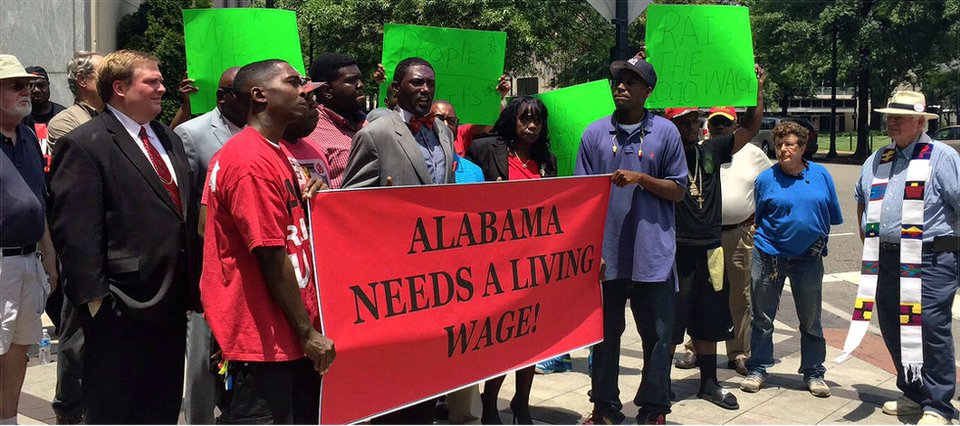

Birmingham low-wage workers rally outside St. Vincent’s Hospital, June 22.
Low-wage workers are winning big victories in their continuing struggle to raise wages and strengthen rights for those in the lowest-paid jobs in the U.S.
After steady pressure from “Fight for $15,” the City Council of Birmingham, Ala., passed an ordinance on Aug. 17 to raise the city minimum wage to $10.10 per hour over the next two years. The federal $7.25 per hour is now the minimum wage in Alabama. “Fight for $15” is a national organization begun by fast food workers to “fight for fair wages and the right to form a union without retaliation.” (fightfor15.org)
The council vote, under review by the city’s legal department, is thought to be the first such law in the southeast U.S. if it goes into effect. (Al.com)
More historic wage-raising victories in Kentucky and North Carolina echo this Deep South gain, made where ruling-class resistance to labor organizing has traditionally been most vicious.
The low-wage movement has surged dramatically, starting with the first New York City, one-day walkout by 200 workers in 2012. In April 2015, tens of thousands of low-wage workers and supporters protested in 200 cities in the movement’s ninth one-day strike. This mobilization of worker strength is one of the longest continuing U.S. labor campaigns since the 1930s.
The rise in low-wage worker organizing has been called an “earthquake,” a “tidal wave” and “an idea whose time has come” by labor analysts. (Guardian, Los Angeles Times)
Led first by fast food workers, the campaign now embraces people in the broadest range of low-wage labor — from car wash, child care, convenience store, fast food, home care and health care workers to adjunct professors and sweatshop big-box warehouse workers.
The low-wage movement and other community struggles are connecting, linking worker rights to students’ right to education, people’s right to water and housing, and the Black Lives Matter demand to freedom from racist state and police terror.
The April 15 action by the Workers Center of Central New York in Syracuse, N.Y., showed the new strength of labor-community bonds. There, low-wage health aides and fast food workers were joined by local union members from auto, civil service, health care, roofing, plumbing, transit, and teaching — and representatives from local anti-war groups, cultural groups, churches, synagogues and mosques.
The power of the movement & the NLRB ruling
In July, a New York state panel appointed by Gov. Andrew Cuomo endorsed a $15 minimum wage for the state’s 180,000 fast food workers. Cities including Seattle, San Francisco and Los Angeles have voted to phase in a $15 minimum wage.
On Aug. 27, the National Labor Relations Board ruled three-to-two that a company that hires a contractor to staff its business or facilities may be considered a “joint employer” of any workers hired. This ruling would affect workers at franchise businesses like those licensed by McDonald’s, among many others.
That means a union representing those workers could legally bargain with the parent company, not just the contractor, on their behalf, as well as challenge labor violations for the workers. (New York Times)
The NLRB is the federal “agency of last resort” for U.S. worker/labor conflicts, charged with “conducting elections for labor union representation and with investigating and remedying unfair labor practices.” (nlrb.gov)
The NLRB ruling could potentially affect millions of U.S. workers. According to the National Employment Law Project, there are about 3.4 million temporary or “staffing-agency” subcontracted jobs alone in the U.S. That’s 2.25 percent of total U.S. employment. The project notes the numbers are doubtless much higher because the U.S. doesn’t track subcontracted workers. (Guardian)
Bourgeois economists, pursuing their own political and economic agendas, have recently backed minimum wage increases; for example, economist Paul Krugman’s op-ed, “Liberals & Wages,” in the July 17 New York Times.
But in an editorial damning the NLRB ruling, the conservative National Review magazine compared workers to bank robbers. Then, in the same article, the National Review admitted business owners regularly subcontracted to evade worker-friendly labor laws.
The Wall Street Journal was aghast at the “radical rewriting of U.S. labor law” by this NLRB decision.
In the face of bitter ruling-class resistance, the recent low-wage worker wins would never have been realized without the fierce struggle of the workers themselves, out in the streets with their communities, “Fighting for $15!”
Africa is rising, the days of colonialism are finished: This is the call being echoed…
Several immigrant groups and their supporters rallied outside the federal courthouse in Philadelphia on May…
Thousands of construction workers and teachers in at least seven provinces throughout Panamá took to…
El imperialismo estadounidense sufrió su segunda derrota histórica el 30 de abril de 1975 a…
As part of Workers World newspaper’s coverage marking the 50th anniversary of the liberation of…
From the PFLP Central Media Office The following statement from the Popular Front for the…